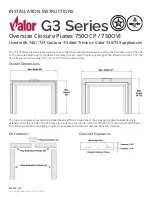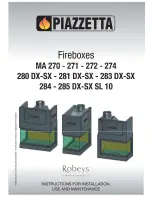
11
Maintenance
Air flow through the fire pit must remain unobstructed. Keep ventilation openings, controls, burner, and air passages
clean and clear of debris. Signs of possible blockage include the following:
o
Gas odor with extreme yellow tipping of flame.
o
Fire pit does not reach the desired temperature.
o
Fire pit glow is excessively uneven.
o
Fire pit makes popping noises.
□
Spiders and insects can nest in the burner or other openings. This dangerous condition can damage the fire pit
and render it unsafe for use. Clean burner holes using a heavy-duty pipe cleaner. Compressed air may help clear
away smaller particles.
Carbon deposits may create a fire hazard. Clean the dome and burner screen with warm soapy water if
any carbon deposits develop.
Care and Cleaning
To enjoy years of outstanding performance from your fire pit, make sure you perform the following maintenance activities
on a regular basis:
•
Keep exterior surfaces clean.
o
Use warm soapy water for cleaning. Never use flammable or corrosive cleaning agents.
o
While cleaning your unit, be sure to keep the area around the burner dry at all times.
o
Do not submerge the control valve assembly. If the gas control is submerged in water, do NOT use it
again. It must be replaced.
•
Keep the appliance area clear and free from combustible materials, gasoline, and other flammable vapors and
liquids.
•
Do not obstruct the flow of combustion and ventilation air.
•
Clean burner holes by using a heavy duty pipe cleaner. Compressed air may help clear away smaller particles.
Storage BETWEEN USES
•
Turn the control knob OFF.
•
Disconnect the LP source.
•
Store the fire pit upright in an area sheltered from direct contact with inclement weather (such as rain,
sleet, hail, snow, dust, and debris).
•
If desired, cover the fire pit to protect the exterior surfaces and to help prevent build-up in air passages.






























